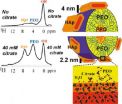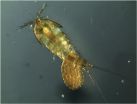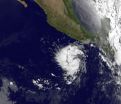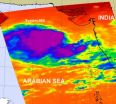(Press-News.org) AMES, Iowa - Bone is one of nature's surprising "building materials." Pound-for-pound it's stronger than steel, tough yet resilient. Scientists at the U.S. Department of Energy's Ames Laboratory have identified the composition that gives bone its outstanding properties and the important role citrate plays, work that may help science better understand and treat or prevent bone diseases such as osteoporosis.
Using nuclear magnetic resonance (NMR) spectroscopy, Ames Laboratory scientist and Iowa State University chemistry professor Klaus Schmidt-Rohr and his colleagues studied bone, an organic-inorganic nanocomposite whose stiffness is provided by thin nanocrystals of carbonated apatite, a calcium phosphate, imbedded in an organic matrix of mostly collagen, a fibrous protein.
By understanding the nanostructure of naturally occurring materials, researchers may be able to develop new light-weight, high-strength materials that will require less energy to manufacture and that could make the products in which they are used more energy efficient.
"The organic, collagen matrix is what makes bones tough," Schmidt-Rohr said, "while the inorganic apatite nanocrystals provide the stiffness. And the small thickness – about 3
nanometers – of these nanocrystals appears to provide favorable mechanical properties, primarily in prevention of crack propagation."
While bone structure has been studied extensively, how these apatite nanocrystals form and what prevents them from growing thicker was a mystery. Some research pointed to sugars being involved, but that didn't match with the NMR spectra that Schmidt-Rohr was seeing.
"We can see all the peaks clearly," he says of a spectral graph which shows the points at which specific components in bone samples resonate; these specific signatures are the key to NMR technology, "even those at the organic-inorganic interface, where the organic material's signal strength is relatively weak."
After studying bone structure over a five-year period, it was actually serendipitous that Schmidt-Rohr came across a signature that appeared to match what he was seeing.
"We had gotten some crystalline collagen samples to study," he said, "and it turned out that the supplier, Sigma-Aldrich, had used citrate to dissolve the collagen. And the citrate signature in the collagen samples matched the signature we were seeing in bone."
According to Schmidt-Rohr, the role of citrate in bone had been studied up until about 1975, but since that time, no mention was made in any of the newer literature on bone. So in essence, his research team had to rediscover it.
The case for citrate was made most convincingly when graduate research assistant Yanyan Hu was able to extract citrate from cow bone and replace it with carbon 13 (C13) -enriched citrate, resulting in a 30-fold enhancement of the NMR signals of the bone sample. The peaks matched exactly, confirming the presence of citrate on the surface where the apatite nanocrystals had formed.
Schmidt-Rohr further hypothesized that, since citrate is too large to be incorporated into the apatite crystal lattice, it must be bound to the nanocrystals' surface where it stabilizes the nanocrystals' size by preventing their further growth. The findings were published in the Dec. 28, 2010 issue of the Proceedings of the National Academy of Sciences.
"Based on the old literature, we looked at the citrate levels in a variety of types of bone and found that herring spine had the highest citrate concentration – about 13 percent by weight," Schmidt-Rohr said. "So it should hold that the citrate signal for herring spine should be three times higher than for cow bone, and indeed it was."
In further studies, the group found that higher concentration of citrate, the thinner the apatite nanocrystals in bone. This was further confirmed on bone-mimetic nanocomposites in a collaboration with Ames Lab faculty scientists Surya Mallapragada and Muffit Akinc, using a polymer template with various concentrations of citrate to synthesize apatite nanocrystals. At higher concentrations, the nanocrystals that formed were thinner and should therefore be more resistant to crack propagation. This work was published in the April 12 issue of Chemistry of Materials.
"At this point, we feel that citrate probably also has a role in the biomineralization of the apatite," Schmidt-Rohr said. "It's also been noted in the literature that as an organism ages, the nanocrystal thickness increases and the citrate concentration goes down," Schmidt-Rohr said, "and there's also support from clinical studies that citrate is good for bones," adding that one of the leading supplements for bone strength contains calcium citrate.
"While calcium loss is a major symptom in osteoporosis, the decline of citrate concentration may also contribute to bone brittleness," he said.
INFORMATION:
The work was supported by DOE's Office of Science. The Ames Laboratory is a U.S. Department of Energy Office of Science national laboratory operated by Iowa State University. The Ames Laboratory creates innovative materials, technologies and energy solutions. We use our expertise, unique capabilities and interdisciplinary collaborations to solve global problems.
Citrate key in bone's nanostructure
2011-06-09
ELSE PRESS RELEASES FROM THIS DATE:
Will psych majors make the big bucks?
2011-06-09
A new crop of college graduates have just landed on the job market. Right now they're probably just hoping to get any job, if at all. However, for psychology majors, the salary outlook in both the short and long term is particularly poor, according to a new study which will be published in an upcoming issue of Perspectives on Psychological Science, a journal of the Association for Psychological Science.
It's generally known that psychology majors don't make a ton of money when they're starting out; they're not like engineering students, many of whom go straight into a ...
How cells' sensing hairs are made
2011-06-09
Body cells detect signals that control their behavior through tiny hairs on the cell surface called cilia. Serious diseases and disorders can result when these cilia do not work properly. New research from UC Davis published this week in the journal Nature Cell Biology provides new insights into how these cilia are assembled.
"It's a basic discovery, but with implications for understanding disease," said Jonathan Scholey, professor of molecular and cellular biology at UC Davis and senior author of the study. Understanding how cilia are assembled and function can help ...
'Thermal pollution' in rivers not fully mediated by gravel augmentation
2011-06-09
Although adding gravel to a river to replace lost sediments won't likely cool the whole river channel, it can create cool water refuges that protect fish from thermal pollution, according to a U.S. Forest Service Pacific Northwest Research Station study.
The research—featured in the June 2011 issue of Science Findings, a monthly publication of the station—is among the first to explore the interplay between sub-surface water flow and temperature in large rivers and is helping to guide river restoration strategies in the Pacific Northwest.
In the study, which began ...
Eating a high-fat diet may rapidly injure brain cells that control body weight
2011-06-09
Obesity among people who eat a high-fat diet may involve injury to neurons, or nerve cells, in a key part of the brain that controls body weight, according to the authors of a new animal study. The results will be presented Tuesday at The Endocrine Society's 93rd Annual Meeting in Boston.
"The possibility that brain injury may be a consequence of the overconsumption of a typical American diet offers a new explanation for why sustained weight loss is so difficult for most obese individuals to achieve," said presenting author Joshua Thaler, MD, PhD, a faculty member with ...
Can evolution outpace climate change?
2011-06-09
Animals and plants may not be able to evolve their way out of the threat posed by climate change, according to a UC Davis study of a tiny seashore animal. The work was published today (June 8) in the journal Proceedings of the Royal Society B.
The tide pool copepod Tigriopus californicus is found from Alaska to Baja California — but in a unique lab study, the animals showed little ability to evolve heat tolerance.
"This is a question a lot of scientists have been talking about," said study co-author Eric Sanford, an associate professor of evolution and ecology at UC ...
UAB first in US with cell-processing workstation
2011-06-09
BIRMINGHAM, Ala. – The University of Alabama at Birmingham has taken a significant step toward making sophisticated cell therapy a part of patient care with its acquisition of the first cell-processing workstation (CPWS) from SANYO North America Corporation (SANYO) in the United States.
Richard Marchase, Ph.D., vice president for Research and Economic Development at UAB, says "UAB has a rich history of breaking ground in the cell-therapy arena. We are thrilled that we were able to be the first in the United States to use SANYO's CPWS. This will add to our world-class ...
A double-satellite NASA-style view of the first tropical storm in eastern Pacific: Adrian
2011-06-09
The first tropical depression in the Eastern Pacific Ocean is now the first tropical storm, and two satellites are providing NASA insights into its thunderstorms, rainfall, and intensity. NASA satellite data on newly born Tropical Storm Adrian shows high cloud tops and moderate rainfall, indications that the storm is getting stronger, triggering a tropical storm watch in Mexico.
Tropical Depression 1E is the first tropical depression of 2011 and formed in the eastern Pacific Ocean early on June 7. By the morning of June 8 it had strengthened into Tropical Storm Adrian, ...
NASA imagery sees a reawakening of system 98A in the Arabian Sea
2011-06-09
System 98A has been bringing rains, gusty winds and churning up the surf along the Arabian Seacoast of west-central India for days, and NASA satellite imagery confirms that it is getting organized now that it has moved into open waters.
NASA's Atmospheric Infrared Sounder (AIRS) instrument onboard NASA's Aqua satellite captured an image on June 8 at 08:47 UTC (4:47 a.m. EDT) of the hundreds of thunderstorms that make up the low pressure area called System 98A. The low pressure area has now moved to the west-southwest and away from Mumbai, India. In fact, today it is located ...
Stable temperatures boost biodiversity in tropical mountains
2011-06-09
Durham, NC — We often think of rainforests and coral reefs as hotspots for biodiversity, but mountains are treasure troves for species too —especially in the tropics, scientists say. But what drives montane biodiversity? The diversity of plants and animals in tropical mountain ranges may have something to do with the stable seasonal temperatures found in the tropics relative to higher latitudes, says a new study by scientists working at the US National Evolutionary Synthesis Center.
The study, based on nearly 200 species of bats, birds, frogs, lizards and snakes, also ...
The diving bell and the water spider: How spiders breathe under water
2011-06-09
Gazing into the depths of a pond, it's hard to miss the insects that whirl and zip beneath the surface. However, only one species of spider has joined them: the diving bell spider, Argyroneta aquatica. 'It is an iconic animal; I had read about the spider as a small boy in popular literature about ponds,' says Roger Seymour from the University of Adelaide. According to Seymour, each spider constructs a net of silk in vegetation beneath the surface and fills it with air carried down on its abdomen. The spiders spend their entire lives submerged and even lay their eggs in ...



